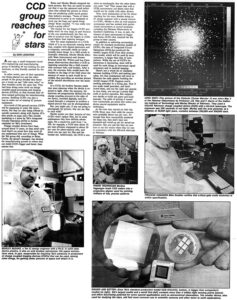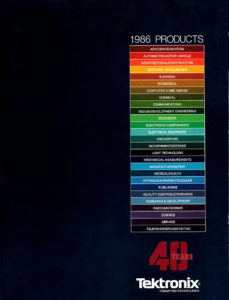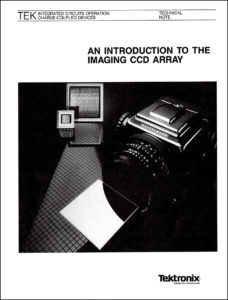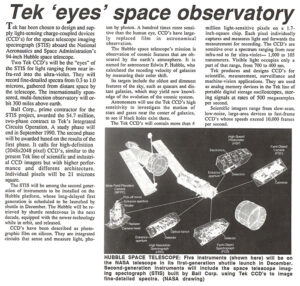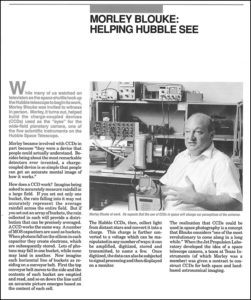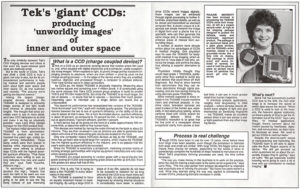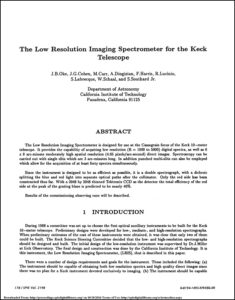Tektronix explored CCD (charge coupled devices) in the 1970s as possible “fast in, slow out” (FISO) transfer devices. The idea was that a high speed clock could sample an analog signal and inject charge packets proportional to the signal into the front end of a fast-clocked CCD. After the samples were collected the clock would switch to a much slower rate for transfer to the slower analog-to-digital converters available at that time. The first MOS CCDs Tektronix investigated were purchased from foundries like Synertek, Merriman or AMI.
The primary application for CCDs devices is sensors for digital imaging. Tektronix developed and produced CCD imagers in the 1980s as part of their Integrated Circuits Operation (ICO). This May 7, 1985 TekWeek article features an overview of the technology and applications. Click on the image to view the PDF.
This 1986 Tektronix catalog describes their technology and features their 2048x2048 CCD imager. Click on the image to view the PDF.
This 1987 brochure describes the Tektronix CCD imagers as well as an overview to CCD fundamentals. Click on the image to view the PDF.
This March 24, 1989 TekWeek article describes the various CCDs planned for the Hubble Space Telescope. Click on the image to view the PDF.
This Focus On Tek Volume 6 Number 3 from 1990 describes Tektronix CCD efforts including working on a second-generation CCD called the Space Telescope Imaging Spectagraph. More information is on our Tektronix and the Hubble Space Telescope page. Click on the image to view the PDF.
Unfortunately a significant flaw in the mirror construction prevented proper telescope operation. The Tektronix imagers were swapped out as part of corrective optics and instruments installed in 1993 to compensate for the mirror flaw.
This August 9, 1991 TekWeek features an article on the new "giant" 2048x2048 CCD array with uses in astronomy and medical imaging. Click on the image to view the PDF.
This CCD is used as the detector on the Low Resolution Imaging Spectrometer (LRIS) for the Cassegrain focus of the Keck 10-meter telescope on Mauna Kea in Hawaii. This paper from the Department of Astronomy at the California Institute of Technology describes the application of the Tektronix CCD. Click on the image to view the PDF.
The Sloan Digital Sky Survey (SDSS) was one of the most ambitious surveys in astronomy. From 2000 to 2008 it obtained high resolution images covering more than a quarter of the sky and created maps of over 930,000 galaxies and 120,000 quasars. The 2.5m f/5 telescope was located at Apache Point Observatory in south east New Mexico. The imaging camera utilized 30 Tektronix/SITe 2048 x 2048 CCDs arranged in a 6 x 5 matrix. A 20" aperture photometric telescope for system calibration utilized a single Tektronix/SITe 2048 x 2048 CCD. More information can be found at the Sloan Digital Sky Survey website
We have a pair of these 2048 x 2048 CCD imagers at the museum.
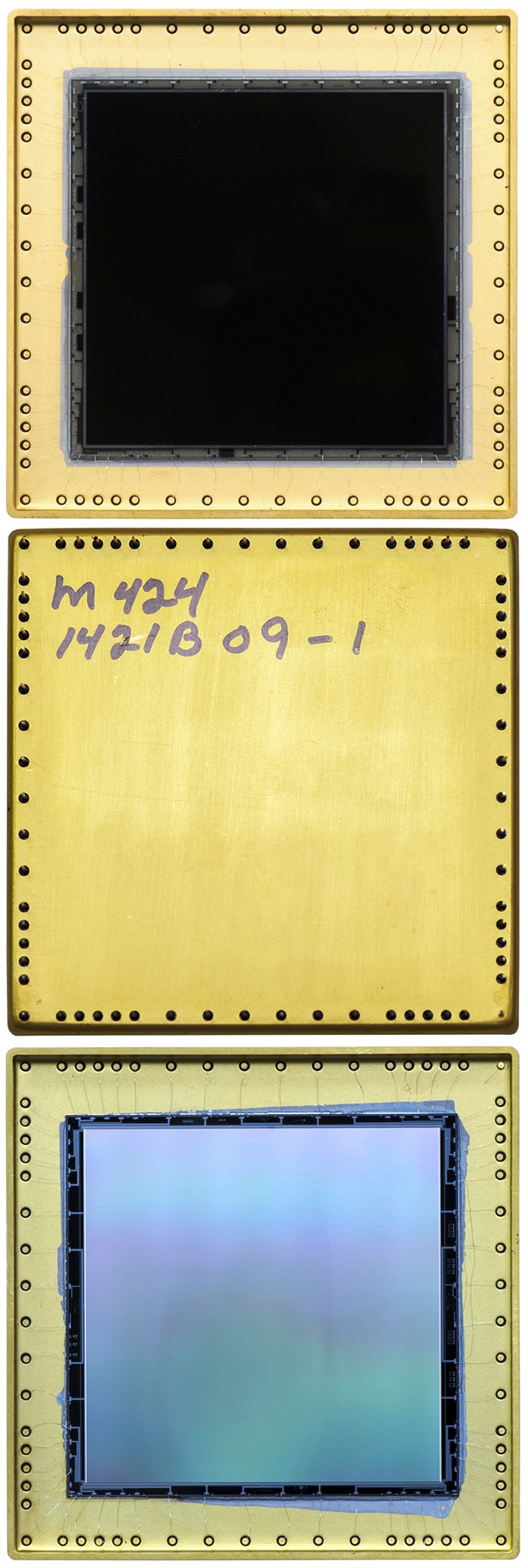
In 1993 the CCD group was spun out of Tektronix to form Scientific Imaging Technologies, Inc., (SITe). SITe continued to develop CCD technology for in-orbit installation in 1997 on the Hubble Space Telescope. The CCD developed at SITe, formerly Tektronix CCD Products Group, is for coverage of the 305 - 1000 nm region for the space telescope imaging spectrograph (STIS) instrument. Thus technology developed at Tektronix found its way onto the Hubble Space Telescope.
John Ferrara, also known as John Morris, wrote an article for the August 2017 issue of the Tek Retiree News. This excerpt describes his memories of the CCD business and the spin off as SITe.
Development of CCD business
There were several engineers led by a Chief Engineer named Dr. Morley Blouke. Morley had a number of patents related to CCDs (Charge Coupled Devices) and started designing some of these for the group. It was at this time now in the early 1990s that the group began selling these designs for electronic imaging. The first customers were major observatories around the world which used the CCDs as the digital image capture feature of cameras mounted on the telescopes. NASA became aware of the CCD group at Tektronix and issued a sub-contract through Ball Aerospace for a second generation STIS (Space Telescope Imaging Spectrograph) or camera system to be installed in the Hubble Space Telescope (HST). The original HST had a defective mirror which made the telescope near-sighted and the camera system was primitive compared to the capability of the Tektronix CCDs at the time. A mission was quickly designed by NASA to add a corrective lens to the HST This was done in 1993. Then an upgrade to the camera system to be higher definition using the Tektronix CCDs was completed in February 1997. Another major customer group was medical imaging which used CCDs for digital mammography (breast cancer detection).Spinoff of CCD business
In late 1993 as Tektronix was planning to divest the Microelectronics business in building 59, they sold the CCD business to a private equity company from Kentucky. The group renamed themselves SITe (Scientific Imaging Technologies). Most of the Tektronix employees about 50 people were hired by the new company. They continued to operate from building 59 by leasing their space from Tektronix. Later in 1996, after Maxim purchased building 59 from Tektronix, SITe moved off campus to continue their business.

